Existing primary old lists of pharaohs
The texts of existing primary old lists of pharaohs are incomplete:
Archibald Sayce gave comparative data on several of these lists in his book
The Ancient Empires of the East (1884),
[2] in addition to the lists found in
Herodotus,
Diodorus,
Eratosthenes,
and even a fanciful list found in "the Arabic writers". Yet another
fanciful list that does not appear in Sayce, is found in the
Book of Sothis that
George Syncellus attributed to Manetho.
Legendary period
In the texts of the Palermo, Turin and Manetho king lists, there are
different versions of names of eight god kings that ruled Egypt in the
beginning.
[citation needed]
These god kings are followed by differing sets of semi-divine rulers.
| Turin King List |
Length |
Manetho |
Length |
| Second dynasty of gods |
unknown |
Dynasty of Halfgods |
unknown |
| 3 Achu-Dynasties |
unknown |
30 Kings from Memphis |
1790 years |
| Dynasty of Disciples of Horus |
unknown |
10 Kings from This |
350 years |
Archaic period
The Archaic period includes the
Early Dynastic Period, when
Lower Egypt and
Upper Egypt were ruled as separate kingdoms.
Early Dynastic: Lower Egypt
Lower Egypt, known as the Black land, consisted of the northern
Nile and the Nile
Delta. The following list may not be complete:
Early Dynastic: Upper Egypt
Upper Egypt, known as the Red Land
[citation needed], consisted of the southern Nile and the
deserts. The following list may not be complete (there are many more of uncertain existence):
| Name |
Image |
Comments |
Dates |
| Scorpion I |
|
Oldest tomb at Umm el-Qa'ab had scorpion insignia |
c. 3200 BC? |
| Iry-Hor |
 |
Kingship uncertain, possibly the immediate predecessor of Ka. |
c. 3150 BC? |
| Ka[4][5] |
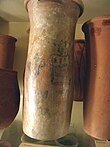 |
Maybe read Sekhen rather than Ka. Possibly the immediate predecessor of Narmer. |
c. 3100 BC |
| King Scorpion |
 |
Potentially read Serqet; possibly the same person as Narmer. |
c. 3150 BC |
| Narmer |
 |
The king who combined Upper and Lower Egypt.[6] |
c. 3150 BC |
First Dynasty
The
First Dynasty
ruled from approximately 3150 to 2890 BC, by some chronological
schemes. (There are no precise or agreed-upon year dates for any of the
Old or Middle Kingdom periods, and reign estimates differ widely from
one Egyptologist to the next.)
| Name |
Image |
Comments |
Dates |
| Narmer |
 |
Believed to be the same person as Menes and to have unified Upper and Lower Egypt. |
c. 3150 BC |
| Hor-Aha |
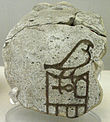 |
— |
c. 3050 BC |
| Djer |
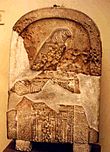 |
— |
41 years |
| Djet |
 |
— |
10 years[7] |
| Merneith |
 |
Female Regent for Den, may have ruled as pharaoh in her own right |
— |
| Den |
 |
First pharaoh depicted wearing the double crown of Egypt, first pharaoh with a golden Horus name. |
42 years[7] |
| Anedjib |
 |
— |
10 years |
| Semerkhet |
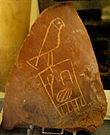 |
— |
9 years |
| Qa'a |
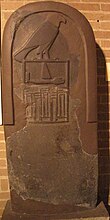 |
— |
2916?–2890 BC |
In the interregnum between the first and second dynasties two short lived pharaohs may have reigned :
| Name |
Image |
Comments |
Dates |
| Sneferka |
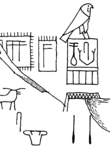 |
Very short reign |
c. 2900 BC |
| Horus Bird |
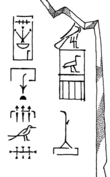 |
Very short reign |
c. 2900 BC |
Second Dynasty
The
Second Dynasty ruled c. 2890 — 2686 BC.
| Name |
Image |
Comments |
Dates |
| Hotepsekhemwy[8] |
 |
— |
25 - 29 years |
| Raneb[9] |
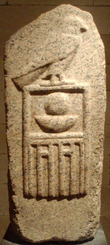 |
Name may be read Nebra rather than Raneb. Could be the same person as Weneg.[10] |
10 - 14 years |
| Nynetjer[11] |
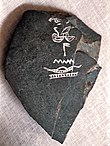 |
May have divided Egypt between his successors |
43 - 45 years |
| Weneg[12] |
|
Could be an independent ruler or the same as Sekhemib-Perenmaat or Raneb |
|
| Senedj[13] |
|
Possibly the same person as Seth Peribsen [14] |
|
| Seth-Peribsen[15] |
 |
May have reigned over Upper Egypt only, could be the same person as Senedj or Sekhemib-Perenmaat.[16] |
|
| Sekhemib-Perenmaat |
 |
May have reigned over Upper Egypt only, could be the same person as Seth-Peribsen.[16] |
|
| Khasekhem(wy)[17][18] |
 |
Reunified Egypt after a period of troubles ca. 2690 BC |
17 - 18 years |
Old Kingdom
The
Old Kingdom
is the period in the third millennium BC when Egypt attained its first
continuous peak of civilisational complexity and achievement (the first
of three so-called "Kingdom" periods which mark the high points of
civilization in the Nile Valley), spanning the period when Egypt was
ruled by the
Third Dynasty through the
Sixth Dynasty (2686–2181 BC). Many
Egyptologists also include the Memphite
Seventh and
Eighth Dynasties in the Old Kingdom as a continuation of the administration centralised at
Memphis. The Old Kingdom was followed by a period of disunity and relative cultural decline referred to by Egyptologists as the
First Intermediate Period—or, as the Egyptians called it, the "first illness."
The royal capital of Egypt during the Old Kingdom was located at
Memphis, where
Djoser established his court. The Old Kingdom is perhaps best known, however, for the large number of
pyramids which were constructed at this time as pharaonic burial places. For this reason, the Old Kingdom is frequently referred to as
"the Age of the Pyramids".
Third Dynasty
The
Third Dynasty ruled from 2686 to 2613 BC.
Fourth Dynasty
The
Fourth Dynasty ruled from 2613 to 2498 BC and included the pharaohs who had the
Great Pyramids built,
Khufu (Cheops),
Khafra (Chephren) and
Menkaura (Mycerinus).
| Name |
Image |
Comments |
Dates |
| Sneferu |
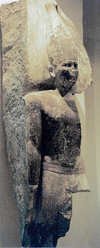 |
Built the Meidum Pyramid and the Bent Pyramid
(341 ft/103m from the base to the tip), which is a pyramid built at a
normal angle at the bottom but drastically changes at the top. He also
built the first "true" pyramid, the Red Pyramid.
Some say that he was buried in the Red Pyramid, while others say that
he was buried in the Bent Pyramid. Bones have been found at the Red
Pyramid, but there is no evidence that this is Sneferu's body. |
2613–2589 (24 years) |
| Khufu |
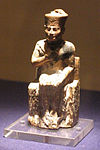 |
Greek form: Cheops. Built the great pyramid of Giza.
Note that Khufu is spoken of in early sources as being "third" of his
family to rule, although there is no known record of a Pharaoh between
Sneferu and Khufu. One supposition is that there might have been a very
short reign of some elder brother of Khufu, whose inscriptions, names,
and monuments have perished for one reason or another. |
2589–2566 |
| Djedefra (Radjedef) |
 |
Believed to have created the Great Sphinx of Giza
as a monument for his deceased father. He also created a pyramid at Abu
Rawash. However, this pyramid is no longer intact as it is believed the
Romans recycled the materials it was made from. Before being demolished
by the Romans, according to a documentary aired by the History Channel,
the pyramid may actually have been the highest ever built (about 20
meters taller than the Great Pyramid of Giza although this is due to its
elevated location rather than the size from base to tip). |
2566–2558 |
| Khafra |
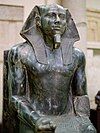 |
Greek form: Chephren His pyramid is the second largest in Giza. Credited by some Egyptologists as the builder of the Great Sphinx of Giza. |
2558–2532 |
| — |
– |
Here some authorities insert Bikheris, following Manetho |
— |
| Menkaura |
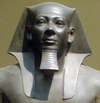 |
Greek form: Mycerinus. His pyramid is the third and smallest in Giza. |
2532–2503 |
| Shepseskaf |
 |
Broke with the tradition of pyramid building and instead had the Mastabat el-Fara'un made for himself |
2503–2498 |
| Djedefptah |
– |
Here some authorities insert Djedefptah a.k.a. Thampthis, following Manetho |
— |
Fifth Dynasty
The
Fifth Dynasty ruled from 2498 to 2345 BC.

























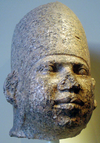






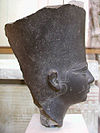




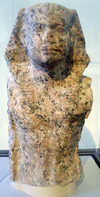

No comments:
Post a Comment